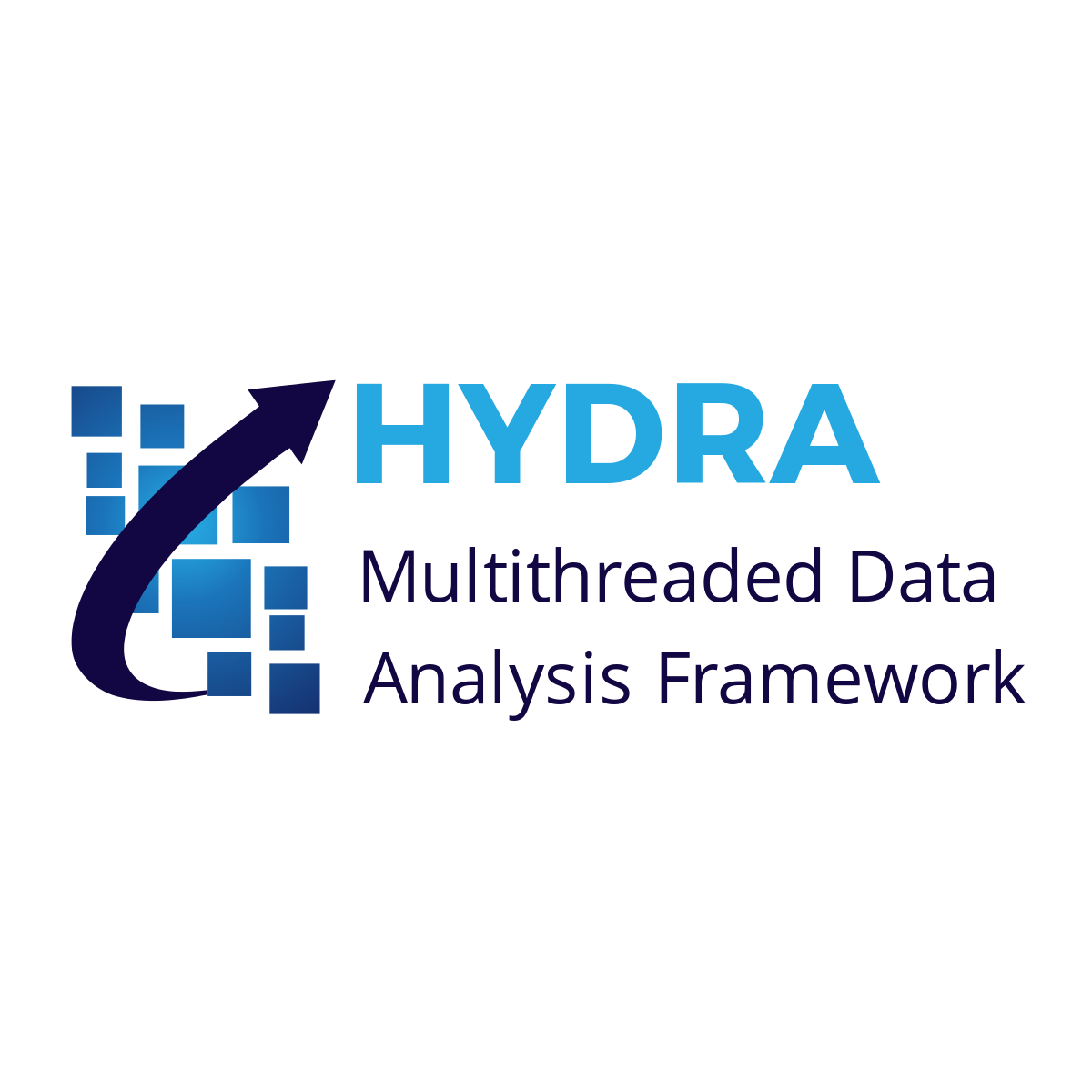Vector Classes¶
There are two vector classes available in Hydra, namely Vector4R and Vector3R.
Vector4R¶
The Vector4R class available in Python wraps the C++ Vector4R class representing
four-dimensional relativistic vectors.
Three types of constructors allow to instantiate the Vector4R class:
- Default empty constructor.
- Copy constructor.
- Constructor from 4 real (
float) numbers.
import HydraPython as hp
vec1 = hp.Vector4R() # construction with values 0.0 for all 4 particals
vec2 = hp.Vector4R(0.8385, 0.1242, 0.9821, 1.2424)
vec3 = hp.Vector4R(vec2) # Copy construct the vec3 from vec2
print (vec1) # (0, 0, 0, 0)
print (vec2) # (0.8385,0.1242,0.9821,1.2424)
print (vec3) # (0.8385,0.1242,0.9821,1.2424)
The Vector4R class also provides a pretty convenient method to create an instance from a python list.
list_ = [0.9241, 0.13223, 0.13121, 1.1141]
vec4 = hp.Vector4R(list_)
This will construct a new Vector4R object with the values passed within
a list. The list should contain exactly 4 elements otherwise a TypeError
will be raised.
The set methods can be used to set all 4 values or a particular value
in a Vector4R object, while the get method can be used with Vector4R
to get the value of a particular index. The __getitem__ and
__setitem methods can also be used to get or set the value which comes
very handy and maintain more pythonic way to access and set the values.
vec5 = hp.Vector4R(0.8385, 0.1242, 0.9821, 1.2424)
print (vec5) # (0.8385,0.1242,0.9821,1.2424)
vec5.set(0, 0.9887)
print (vec5) # (0.9887,0.1242,0.9821,1.2424)
vec5.set(0.1234, 0.5118, 0.9101, 0.1121)
print (vec5) # (0.1234,0.5118,0.9101,0.1121)
print (vec5[1]) # 0.5118
print (vec5.get(1)) # 0.5118
vec5[1] = 0.5678
print (vec5) # (0.1234,0.5678,0.9101,0.1121)
The Vector4R object can be multiplied or divided by a real value while it
can be added or subtracted with another Vector4R object. One Vector4R
object can be multiplied by another Vector4R object.
vec6 = hp.Vector4R(0.8215, 0.9241, 0.0105, 1.1994)
vec6 *= 1.1
print (vec6) # (0.90365,1.01651,0.01155,1.31934)
vec6 /= 0.6
print (vec6) # (1.50608,1.69418,0.01925,2.1989)
vec7 = hp.Vector4R(0.1223, 0.6433, 0.1234, 0.3010)
vec6 += vec7 # Add vec6 with the values of vec7
print (vec6) # (1.62838,2.33748,0.14265,2.4999)
vec6 -= vec7
print (vec6) # (1.50608,1.69418,0.01925,2.1989)
Two Vector4R objects can easily be added, subtracted or multiplied:
v = v1 + v2# Returns a Vector4R objectv = v1 - v2# Returns a Vector4R objectv = v1 * v2# Returns a real number
All above three are valid for any Vector4R object. There are various
other methods available in Vector4R. The list of Vector4R
methods can be found on [1].
The Vector4R provides an assign method to assign or copy the Vector4R
object. This is a very useful method to avoid the nasty bugs for example:
vec = hp.Vector4R(0.2010, 0.3010, 0.0210, 0.8385)
vec2 = hp.Vector4R()
# Do things and later in code ...
vec2.assign(vec)
vec == vec2 # True since all values are equal
vec is vec2 # False
vec = vec2 # Reference is copied
vec == vec2 # True
vec is vec2 # True
Vector3R¶
The Vector43 class available in Python wraps the C++ Vector3R class representing
three-dimensional Euclidian vectors.
Three types of constructors allow to instantiate the Vector3R class:
- Default empty constructor.
- Copy constructor.
- Constructor from 3 real (
float) numbers.
import HydraPython as hp
vec1 = hp.Vector3R() # construction with values 0.0 for all 3 particals
vec2 = hp.Vector3R(0.8385, 0.1242, 0.9821)
vec3 = hp.Vector3R(vec2) # Copy construct the vec3 from vec2
print (vec1) # (0,0,0)
print (vec2) # (0.8385,0.1242,0.9821)
print (vec3) # (0.8385,0.1242,0.9821)
The Vector3R class also provides a pretty convenient method to create an
object from python list.
list_ = [0.9241, 0.13223, 0.13121]
vec4 = hp.Vector3R(list_)
This will construct a new Vector3R object with the values passed within
a list. The list should contain exactly 3 elements otherwise a TypeError
will be raised.
The set methods can be used to set all 3 values or a particular value
in a Vector3R object, while the get method can be used with Vector3R
to get the value of a particular index. The __getitem__ and
__setitem methods can also be used to get or set the value which comes
very handy and maintain more pythonic way to access and set the values.
vec5 = hp.Vector3R(0.8385, 0.1242, 0.9821)
print (vec5) # (0.8385,0.1242,0.9821)
vec5.set(0, 0.9887)
print (vec5) # (0.9887,0.1242,0.9821)
vec5.set(0.1234, 0.5118, 0.9101)
print (vec5) # (0.1234,0.5118,0.9101)
print (vec5[1]) # 0.5118
print (vec5.get(1)) # 0.5118
vec5[1] = 0.5678
print (vec5) # (0.1234,0.5678,0.9101)
The Vector3R object can be multiplied or divided by a real value while it
can be added or subtracted with another Vector3R object. One Vector3R
object can be multiplied by another Vector3R object.
vec6 = hp.Vector3R(0.8215, 0.9241, 0.0105)
vec6 *= 1.1
print (vec6) # (0.90365,1.01651,0.01155)
vec6 /= 0.6
print (vec6) # (1.50608,1.69418,0.01925)
vec7 = hp.Vector3R(0.1223, 0.6433, 0.1234)
vec6 += vec7 # Add vec6 with the values of vec7
print (vec6) # (1.62838,2.33748,0.14265)
vec6 -= vec7
print (vec6) # (1.50608,1.69418,0.01925)
Two Vector3R objects can easily be added, subtracted or multiplied:
v = v1 + v2# Returns a Vector3R objectv = v1 - v2# Returns a Vector3R objectv = v1 * v2# Returns a real number
All above three are valid for any Vector3R object. There are various
other methods available in Vector3R. The list of Vector3R
methods can be found on [2].
The Vector3R provides an assign method to assign or copy the Vector3R
object. This is a very useful method to avoid the nasty bugs for example:
vec = hp.Vector3R(0.2010, 0.3010, 0.0210)
vec2 = hp.Vector3R()
# Do things and later in code ...
vec2.assign(vec)
vec == vec2 # True since all values are equal
vec is vec2 # False
vec = vec2 # Reference is copied
vec == vec2 # True
vec is vec2 # True
| [1] | The method list for Vector4R
|
| [2] | The method list for Vector3R
|
